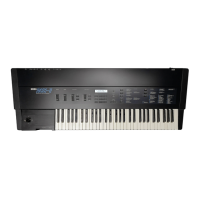Truncation offers a way of getting a single full cycle from
a sampled waveform. Both the additive synthesis and
hand drawing methods give you just a single full cycle to
start with.
You get a single full cycle.
If you are going to loop or link a truncated waveform
then you may want to take advantage of the truncate
function's auto zero cross search function. This makes
sure that the waveform is cut at the zero cross point,
thereby avoiding undesirable noise in the reproduced
sound. Cutting at the zero cross point assures a smooth
crossover for linking.
Truncate also lets you throw away unneeded parts of
sampled waveforms, so you can conserve limited
memory space. (For details, see the section on data
management on page 4B -.)
Using the truncate function's auto zero cross search
function.
Automatically finds
the crossover
points.
o
0
The connections wilt be messy if
you cut like this.
A^/WWV
^ ^
------
^ ^ N o t smooth
But you get smooth crossover jf
you cut at The zero cross points.
W V /V - -
■ The reverse editing function (ii) gives an effect like a
tape played in reverse. The waveform data is re
versed and stored from back to front.
The reverse function is most effective with sampled
waveforms that contain large changes in volume and
timbre.
• The reverse function
1
Data is stored
in reverse
order.
34

